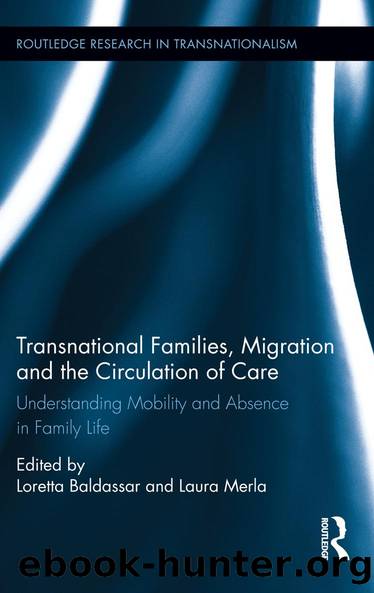Transnational Families, Migration and the Circulation of Care by Loretta Baldassar Laura Merla

Author:Loretta Baldassar, Laura Merla [Loretta Baldassar, Laura Merla]
Language: eng
Format: epub
ISBN: 9781135132248
Barnesnoble:
Publisher: Taylor & Francis
Published: 2013-09-11T00:00:00+00:00
Research Methods
In-depth interviews were conducted over a three-month period in 2010 with fifty-four Ghanaian children and adolescents aged twelve to twenty-two, who had either one or both parents living in a Western country at the time of the interview. The children were selected from a larger survey of Ghanaian school children (N = 2,670) carried out in four different localities in mid-2010 as part of the âTransnational Child Raising Arrangements between Ghana and the Netherlandsâ (TCRA) research project.1 Children were selected for in-depth interviews from Accra (n = 25) and Kumasi (n = 29), both of which are urban regions known for their high ratio of migration to the West, as indicated by remittances received from abroad (Mazzucato et al. 2005). The main criteria for selecting the children were based on TCRA type, that is, having a mother abroad (n = 17), a father abroad (n = 25) or both parents abroad (n = 12). By studying these three family configurations, we took the diversity in the structure of transnational families into account. We selected both boys (n = 21) and girls (n = 33) who attended either junior high schools (JHS) (n = 24) or secondary high schools (SHS) (n = 32). We strove to incorporate diversity in the number of caregiver changes experienced by the children and the childrenâs emotional well-being as measured by the Strength and Diffi culties Questionnaire (Goodman et al. 1998).
A majority of parents of the selected children were residing in the United States and the United Kingdom. Other parents resided in Germany, the Netherlands and Italy. Table 7.1 shows that for the majority of cases, parental migration took place when the child was between the ages of six and thirteen. Fathers were more likely than mothers to leave the children before the age of six. Children who had at least a father abroad were younger and separated from their parent for a longer period of time compared with children who had at least a mother abroad. In our sample, the majority of caregivers were female and kin (see Table 7.2).
The interviews were conducted at schools during breaks or after school hours. We sought permission from the schools to interview the children. The school setting was perceived as a place where children would feel safe and free to voice their opinions without the influence of caregivers or other adults. Each interview lasted between forty-five minutes to one and a half hours and was recorded with the childâs permission. The interviews were subsequently transcribed and analysed with the aid of the qualitative data software Atlas.ti.
Although some child-centred studies call for âchild-friendly methodsâ, such as drawing, we found, in line with Notermans (2008), that in-depth interviews in a formal interview setting were most effective in terms of allowing children to express themselves. In contexts such as Ghana, where it is common for children and adults to occupy different spheres in their daily lives, the formal interview setting aligned most closely with childrenâs ideas
Download
This site does not store any files on its server. We only index and link to content provided by other sites. Please contact the content providers to delete copyright contents if any and email us, we'll remove relevant links or contents immediately.
Nudge - Improving Decisions about Health, Wealth, and Happiness by Thaler Sunstein(7622)
iGen by Jean M. Twenge(5368)
The Fire Next Time by James Baldwin(5252)
Adulting by Kelly Williams Brown(4489)
The Hacking of the American Mind by Robert H. Lustig(4319)
The Sports Rules Book by Human Kinetics(4301)
The Ethical Slut by Janet W. Hardy(4178)
Captivate by Vanessa Van Edwards(3796)
Mummy Knew by Lisa James(3637)
In a Sunburned Country by Bill Bryson(3486)
The Worm at the Core by Sheldon Solomon(3437)
Ants Among Elephants by Sujatha Gidla(3417)
The 48 laws of power by Robert Greene & Joost Elffers(3032)
Suicide: A Study in Sociology by Emile Durkheim(2975)
The Slow Fix: Solve Problems, Work Smarter, and Live Better In a World Addicted to Speed by Carl Honore(2950)
Humans of New York by Brandon Stanton(2835)
The Tipping Point by Malcolm Gladwell(2829)
Handbook of Forensic Sociology and Psychology by Stephen J. Morewitz & Mark L. Goldstein(2660)
The Happy Hooker by Xaviera Hollander(2656)
